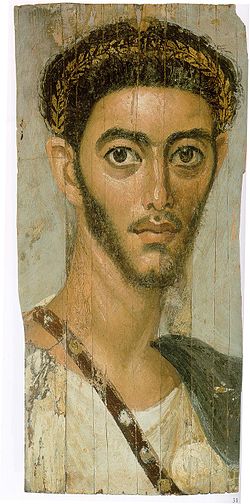Fayyum-porträtt
 |  |
| Fayyum-porträtt utförda i enkaustik på trä. | |
Fayyum-porträtt kallas ett stort antal (omkring sjuhundra) målningar från perioden 100-300 e.Kr. som utfördes i enkaustik, dvs varmt, pigmenterat bivax, på träpannå och fästes vid den avlidnes mumie. De flesta porträtten härstammar från den egyptiska staden Fayyum, i det som då var en romersk provins, där det varma och torra klimatet har bevarat målningarna in i modern tid.[1]
De flesta fayyum-porträtten föreställer unga människor, och många avbildar barn. Moderna undersökningar av mumierna har påvisat en överensstämmelse mellan porträtten och de avlidnas kön och ålder, vilket antyder den blygsamma förväntade medellivslängden under denna period. Man har också föreslagit att dessa målningar ursprungligen ska ha varit väggmålningar som antingen kopierats eller direkt flyttats till graven.
Tillsammans med fresker och andra objekt från Pompeji och Herculaneum och gravmålningar funna i Makedonien , utgör fayyum-porträtten de bäst bevarade målningarna från konsten under antiken. Porträtten uppvisar en häpnadsväckande naturalism, och man antar därför att de målats under den avbildades livstid. Det är däremot omdiskuterat hur realistiska porträtten är. Jämförelser mellan ett stort antal porträtt antyder att konstnärerna snarare återgav ett antal arketyper med variationer i frisyr och skägg. Proportionsskillnaderna är små och individuella karaktärsdrag saknas, jämfört med den psykologiska realismen i den romerska porträttkonsten, i princip helt (se romersk konst).
Fayyum-porträtten tros ha utgjort en viktig utgångspunkt för ikonmåleriet i den bysantinska konsten.
Idag finns fayyum-porträtten sprida i museer över hela världen, till exempel i Louvren och British Museum.
Se även
Referenser
- ^ Jan Picton, Stephen Quirke, Paul C. Roberts (ed): Living Images, Egyptian Funerary Portraits in the Petrie Museum, Walnut Creek CA 2007 ISBN 978-1-59874-251-0
Externa länkar
- British Museum - Proportioner och personlighet i fayyum-porträtten
 Wikimedia Commons har media som rör Fayyum-porträtt.
Wikimedia Commons har media som rör Fayyum-porträtt.
Media som används på denna webbplats
Portrait of a woman in encaustic on limewood: a large crack splits the panel from top to bottom through the proper right eye, and a shorter crack runs through the left eye. The paint surface is damaged in several places. Traces of the mummy wrappings appear at the upper corners. The background was painted in bluish grey with long brush-strokes.
The figure appears very large in relation to the background and is shown in three-quarter view. She wears a claret-coloured tunic with a very dark crimson clavus edged with gold, visible on the proper right side. A mantle of mauvish tone is draped around the shoulders.
The woman wears gold ball earrings (painted with white highlights) typical of the later first century AD. She wears around her neck a gold chain with pendant crescent with ball-shaped terminals: this too is painted with creamy-white highlights. It is not out of the question that she originally had an ornamental chain across the hair, separating the bun on the crown from the locks in front - a feature of other Neronian portraits. Of this, nothing survives but a greyish ground. The front hair is arranged around the brow in two banks of snail-shaped curls, expanded to four above the ears. Locks fall behind the ears to either side of the neck; the necklace has been painted over the lock on the proper right side.
The eyes (especially the proper left eye) are large and rounded, with arched eyebrows. The nose is rather shorter than the norm; the lips are full and painted rose pink. The creamy flesh is tinted pink on the cheeks and chin, and a creamy-white highlight runs down the nose and above and below the lips.
